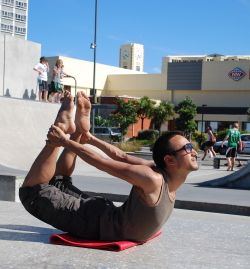by Kara-Leah Grant
As a yoga teacher, my goal is to inspire my students to practice yoga at home.
It’s great when people get themselves to classes three times a week, but the true benefits of yoga really start to unfold when you commit to just showing up on your mat by yourself and seeing what happens.
In a class, your focus is both internal and external. You’re listening to the teacher and watching the demonstrations while also paying attention to what’s going on inside of you.
When you practice at home, there is no need to focus on anything external, so 100% of your attention is on how your body feels, what your breath is doing and how your mind is reacting.
When I talk about building a home practice, I’m not talking about using a DVD either. DVDs can be useful and it might be how you begin to get into the habit of practicing at home, but in essence, it’s exactly the same as going to class because your focus is still largely external.
But making that shift can be extremely intimidating. How will you know what to do? What if you get it wrong?
Trust me on this one – you will amaze yourself with how much understanding you’ve absorbed from going to class.
And you will also amaze yourself with how much innate wisdom there is within you. This is one of the major benefits of practicing at home – it strengthens your connection to your internal Guru.
We ALL have a yoga teacher living inside of us. Problem is, until we start listening to the voice of that teacher, it’s hard to distinguish them from all the other voices inside of us. Like those voices that say:
“You don’t know what you’re doing.”
“This is so silly, it’s just not the same.”
“I’m bored, let’s go watch TV.”
These are the many voices of the mind, and hopefully through going to classes you’ve already begun the discipline of ignoring these voices, and you’ve begun to practice simply being the witness to them.
The inner voice of your Guru comes from a different place and has a different tone. He or she is encouraging, welcoming, kind and compassionate.
This guru will suggest things in a whisper that come from your heart. Things like,
“Remember that triangle pose we did last week, let’s play around with that. If we just start with the feet position, I’m sure we can remember it.”
Every time you ignore the doubts, criticisms and distractions of the mind, and instead listen to the gentle whisperings of your heart, you make a tiny shift toward a different way of living. Building your home yoga practice will greatly enhance and strengthen this shift.
The easiest way to get started is to note that you don’t have to remember all the different postures exactly. All you have to remember are the principles of practice.
The Principles of Home Yoga Practice:
- Have no expectations of what a home practice “should” look like. Instead, give yourself permission to explore your home practice on your mat with an open mind.
- Begin simply with the intention of getting on your mat for “five minutes to see what happens.”
- Always, always, always listen to your breath, follow your breath, pay attention to your breath. Your breath is your teacher – if it’s strained, back off, if if you’re breathing through your mouth, back off, if you’re gasping for air, back off.
- Always listen to your body and never go into anything that’s painful. Discomfort is ok -use the breath to surrender to it. But pain is a signal to back away.
- Remember that alignment is simply A-Line-Ment – things line up. So if you can’t remember the posture exactly, examine your body and make sure that everything lines up – ankles in line with knees, knees in line with hips, hands in line with shoulders. Very rarely are there strange angles in yoga – instead think mathematically. This is parallel to that, or that is perpendicular to this.
- The order of postures is simple – begin with warm-up postures, for example child’s pose, or legs up the wall. Transition into standing postures. Finish standing postures with balancing postures. Practice some floor postures. Always end with a closing sequence – in my classes we use bridge pose, a reclining twist, and corpse pose.
- Pay attention to what your internal guidance is saying from posture to posture. Your body KNOWS what it needs to do next, and when you surrender to it’s natural flow, you can harness this and intuitively do the postures in an order which systematically opens up the body. So if you come out of a series of sun salutations and a thought pops up, “I really feel like surrendering into a forward bend right now,” then honour that thought.
- If your body wants to move in new and unexpected ways, allow it to, staying connected to your breath and paying attention to how your body feels from the inside out. Don’t allow the mind to squash the impulse with a thought like “Oh that’s not a real posture.” What is a “real” posture? And how do you think the very first yogis learned yoga? They learned it by allowing it to blossom from within.
- Don’t skip savasana. You’re at home, so hopefully have some time. This is your opportunity to REALLY explore savasana. It’s your meditative posture where amazing things can happen. So when it comes to the end, allow yourself the great gift of surrendering into savasana for ten minutes, or even twenty minutes. Don’t drift off into sleep though – maintain a conscious awareness!
- Enjoy yourself! This is your practice, it’s a joyful exploration of the internal landscape of your body. Smile when you’re in the postures, congratulate yourself for getting on to your mat, give yourself a pat on the back when you finish. You’re giving yourself the greatest gift ever when you practice at home – the gift of spending time with yourself.
When you start practicing at home, it does also help to start building up a yoga library. I have many fantastic books that I love to dip into and out of, always picking up new understandings.
Some of these books can also have great home practices hat you can learn and use. However, you certainly don’t need a book so learn from, and sometimes having one there while you practice is distracting as it means you are again focusing on an external authority to guide your practice.
But I will mention three of my favourite yoga books for building a home yoga practice.
- Power Yoga by Beryl Bender Birch – I love this book because it’s very clear in it’s instructions and has great photos of all the postures. But I love it even more because of the story of Beryl’s journey into yoga and the way she describes the eight limbs of yoga. I did use it when I was building up my power yoga sequence. But I’ve probably used it more as inspiration for all the other gems of wisdom in it.
- Journey into Power by Baron Baptiste – This is both a book and a DVD, and I’ve used both extensively. I love Baron and the way he talks about yoga. “”Every single one of us is suffering from the same problem,” says Baron Baptiste. “We are not living from our authentic selves.” Journey into Power offers more than yoga poses; it also aims to “rewire your mind” and “recharge your spiritual batteries.”
- Yoga, the poetry of the body by Rodney Yee – This is a great book for developing your home practice because it contains a number of short, simple home practices designed around concepts like Grounding, Resistance and Alignment. It’s also got fascinating discussion between Rodney and journalist Nina Zolotow. A great read all round.
So there you have it – everything you need to know to start building up your home yoga practice. So, get a mat, find a space, and start practicing!
Remember, it’s doesn’t have to be long and complicated. If you just start with child’s pose, three sun salutations, bridge, reclining twist and savasana, you will have had a GREAT practice. This is your foundation, your beginning, the first step in your journey. Now you can build.


I’m so glad to see that you recommend Power Yoga by Beryl Bender Birch. It’s one of my favorites as well. After reading this post I’m ready to go home and start some practice!!
Thank you!!
Yeah! Home practice rocks. Hope you have a great one, and it’s the start of many more.
Blessings,
KL
After reading your posts over the week about teachers having a home practice and the comments for and against your posts, and I could see both sides. There almost seemed to be an ego thing going on with you saying teachers should be doing it how you suggest, but then you do make valid points about a teacher having to be present and the only way to understand that is to have done and be doing it for yourself. Anyway I am still following you and I really enjoyed this post with some good points on how to get your home practice going. I enjoy my home practice and do encourage my students to get on their mats at home. One of the key points is as you said – is keeping it simple and just start for say 5 mins and see how it evolves and how it feels, and once you have accomplished that it is easier each time and before you know it 5 mins has become half an hour.